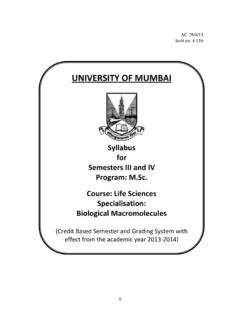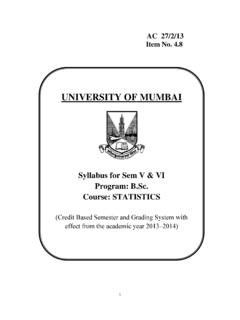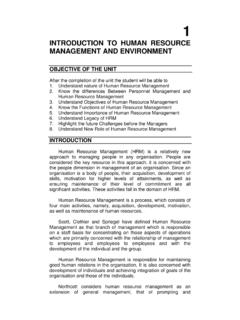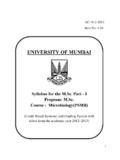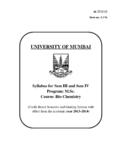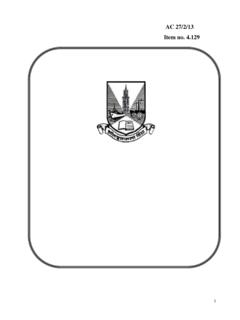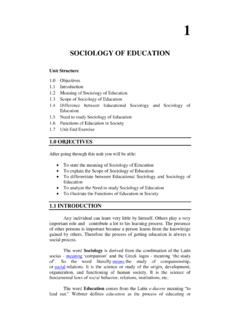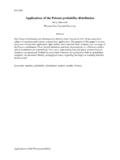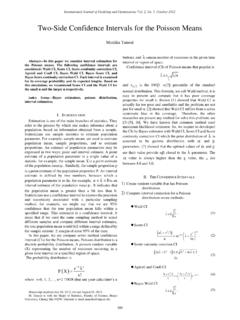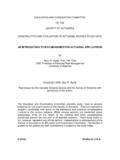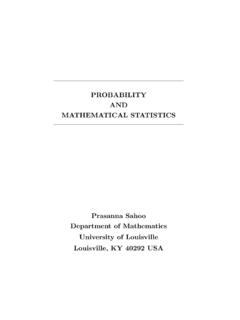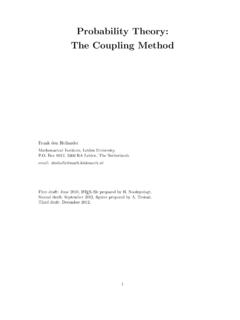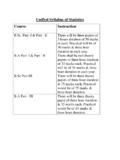Transcription of UNIVERSITY OF MUMBAI
1 AC 19-3-2012 Item UNIVERSITY OF MUMBAI Syllabus for the Program: Course : STATISTICS (Credit Based Semester and Grading System with effect from the academic year 2012 2013) 2 STATISTICS Syllabus Credit Based and Grading System To be implemented from the Academic year 2012-2013 SEMESTER III Course Code UNIT TOPICS Credits L / WeekUSST301 I Univariate Random Variables. (Discrete and Continuous) 2 1 II Standard Discrete probability III Bivariate probability USST302 I Concepts of Sampling and Simple Random Sampling. 2 1 II Stratified Sampling. 1 III Ratio and Regression USST303 I Linear Programming Problem. 2 1 II Transportation Problem. 1 III Assignment & Sequencing Problem. 1 USSTP3 Practicals based on all courses in theory 3 9 SEMESTER IV Course Code UNIT TOPICS Credits L / WeekUSST401 I Standard Continuous probability Distributions.
2 2 1 II Normal Distribution. 1 III Exact Sampling Distributions. 1 USST402 I Analysis of Variance. 2 1 II Design Of Experiments, Completely Randomized design & Randomized Block Design. 1 III Latin Square Design & Factorial Experiments. 1 USST403 I CPM and PERT. 2 1 II Control charts. 1 III Lot Acceptance Sampling Plans By Attributes. 1 USSTP4 Practicals based on all courses in theory 3 9 3 Course Code Title Credits USST301 probability DISTRIBUTIONS 2 Credits (45 lectures ) Unit I : Univariate Random Variables (Discrete and Continuous): Moment Generating Function, Cumulant generating Function-Their important properties. Relationship between moments and cumulants and their uses. Characteristic Function- Its properties (without proof). Transformation of random Variable15 LecturesUnit II :Standard Discrete probability Distributions: Uniform, Bernoulli, Binomial, Poisson, Geometric, Negative Binomial & Hypergeometric distributions.
3 The following aspects of the above distributions(wherever applicable) to be discussed: Mean, Mode and Standard deviation. Moment Generating Function, Cumulant Generating Function, Additive property, Recurrence relation for central Moments, Skewness and Kurtosis (without proof), Limiting distribution. Fitting of Distribution. Truncated Binomial and Truncated Poisson Distribution: Suitable illustrations, probability mass function, mean. 15 LecturesUnit III : Bivariate probability Distributions: Joint probability mass function for Discrete random variables, Joint probability density function for continuous random variables. Their properties. Marginal and conditional Distributions. Independence of Random Variables. Conditional Expectation & Variance. Regression Function. Coefficient of Correlation.
4 Transformation of Random Variables and Jacobian of transformation with illustrations. 15 Lectures REFERENCES: 1. Introduction to the theory of statistics: A. M. Mood, Graybill, D. C. Boyes, Third Edition; McGraw-Hill Book Company. 2. Introduction to Mathematical Statistics: , Craig; Fourth Edition; Collier McMillan Publishers. 3. probability and Statistical Inference: , E. , Third Edition; Collier McMillan Publishers. 4. John E. Freund s Mathematical Statistics: I. Miller, M. Miller; Sixth Edition; Pearson Education Inc. 5. Introduction to Mathematical Statistics: Hoel; Fourth Edition; John Wiley & Sons Inc. 6. Fundamentals of Mathematical Statistics: Gupta, Kapoor; Eighth Edition; Sultan Chand & Sons. 7. Mathematical Statistics: Kapur, Saxena; Fifteenth Edition; S. Chand & Company Ltd. 8. Statistical Methods: An Introductory Text: J.
5 Medhi; Second edition; Wiley Eastern Ltd. 9. An Outline of Statistical Theory Vol. 1: Goon, Gupta, B. DasGupta; Third Edition; The World Press Pvt. Ltd. 10. Statistical Methods Using R Software :V. R. Pawagi and Saroj A. Ranade ;Nirali Publications. 11. Statistics Using R. S. G. Purohit, S. D. Gore, and S. R. Deshmukh. Narosa Publishing House. 4 Course Code Title Credits USST302 THEORY OF SAMPLING 2 Credits (45 lectures ) Unit I : Concepts: Population, Population unit, Sample, Sample unit, Parameter, Statistic, Estimator, Bias, Unbiasedness, Mean square error & Standard error. Census survey, Sample Survey. Steps in conducting a sample survey with examples on designing appropriate Questionnaire. Concepts of Sampling and Non-sampling errors. NSSO, CSO and their functions. Concepts and methods of probability and Non probability sampling.
6 Simple Random Sampling: (SRS). Definition, Sampling with & without replacement (WR/WOR). Lottery method & use of Random numbers to select Simple random sample. Estimation of population mean & total. Expectation & Variance of the estimators, Unbiased estimator of variance of these estimators. (WR/WOR). Estimation of population proportion. Expectation & Variance of the estimators, Unbiased estimator of variance of these estimators. (WR/WOR). Estimation of Sample size based on a desired accuracy in case of SRS for variables & attributes. (WR/WOR).15 LecturesUnit II : Stratified Sampling: Need for Stratification of population with suitable examples. Definition of Stratified Sample. Advantages of stratified Sampling. Stratified Random Sampling: Estimation of population mean & total in case of Stratified Random Sampling (WOR within each strata).
7 Expectation & Variance of the unbiased estimators, Unbiased estimators of variances of these estimators. Proportional allocation, Optimum allocation with and without varying costs. Comparison of Simple Random Sampling, Stratified Random Sampling using Proportional allocation & Neyman LecturesUnit III : a. Ratio & Regression Estimation assuming SRSWOR: Ratio Estimators for population Ratio, Mean & Total. Expectation & MSE of the Estimators. Estimators of MSE. Uses of Ratio Estimator. Regression Estimators for population Mean & Total. Expectation & Variance of the Estimators assuming known value of regression coefficient b . Estimation of b . Resulting variance of the estimators. Uses of regression Estimator. Comparison of Ratio, Regression & mean per Unit estimators. b. Introduction to Systematic sampling, Cluster sampling & Two Stage sampling with suitable LecturesREFERENCES: 1.
8 Sampling Techniques: Cochran; 3rd Edition; Wiley(1978) 2. Sampling Theory and methods: Murthy; Statistical Publishing Society. (1967) 3. Sampling Theory: Des Raj; McGraw Hill Series in probability and Statistics. (1968). 4. Sampling Theory of Surveys with Applications: Sukhatme and Sukhatme; 3rd Edition; Iowa State UNIVERSITY Press (1984). 5. Fundamentals of Applied Statistics: S. C. Gupta and Kapoor; 3rd Edition; Sultan Chand and Sons (2001). 6. Theory and Analysis of Sample Survey Designs: Daroga Singh, , Wiley Eastern Ltd. (1986). 5 7. Sampling Theory and Methods: S. Sampath, Second Edition (2005),Narosa. 8. Theory and Methods of Survey Sampling: Parimal Mukhopadhyay, (1998), Prentice Hall Of India Pvt. Ltd. Course Code Title Credits USST303 OPERATIONS RESEARCH 2 Credits (45 lectures ) Unit I : Linear Programming Problem ( ) : Mathematical Formulation: Maximization & Minimization.
9 Concepts of Solution, Feasible Solution, Basic Feasible Solution, Optimal solution. Graphical Solution for problems with two variables. Simplex method of solving problems with two or more variables. Big M method. Concept of Duality. Its use in solving Relationship between optimum solutions to Primal and Dual. Economic interpretation of Dual. 15 LecturesUnit II : Transportation Problem: Concept, Mathematical Formulation. Concepts of Solution, Feasible Solution. Initial Basic Feasible Solution by North-West Corner Rule, Matrix Minima Method, Vogel s Approximation Method. Optimal Solution by MODI Method. Optimality test, Improvement procedure. Variants in Transportation Problem: Unbalanced, Maximization type. 15 LecturesUnit III :Assignment Problem: Concept. Mathematical Formulation Solution by: Complete Enumeration Method and Hungarian method.
10 Variants in Assignment Problem: Unbalanced, Maximization type. Travelling Salesman Problem Sequencing : Processing n Jobs through 2 and 3 Machines & 2 Jobs through m Machines. 15 Lectures REFERENCES 1. Operations Research: Kantiswaroop and Manmohan Gupta. 4th Edition; S Chand & Sons. 2. Schaum Series book in Richard Broson. 2nd edition Tata Mcgraw Hill Publishing Company Ltd. 3. Operations Research: Methods and Problems: Maurice Sasieni, Arthur Yaspan and Lawrence Friedman, (1959), John Wiley & Sons. 4. Mathematical Models in Operations Research : J K Sharma, (1989), Tata McGraw Hill Publishing Company Ltd. 5. Principles of Operations Research with Applications to Management Decisions: Harvey M. Wagner, 2nd Edition, Prentice Hall of India Ltd. 6. Operations Research: edition, Kedar Nath Ram Nath & Company. 7. Operations Research: H. edition, Prentice Hall of India.


